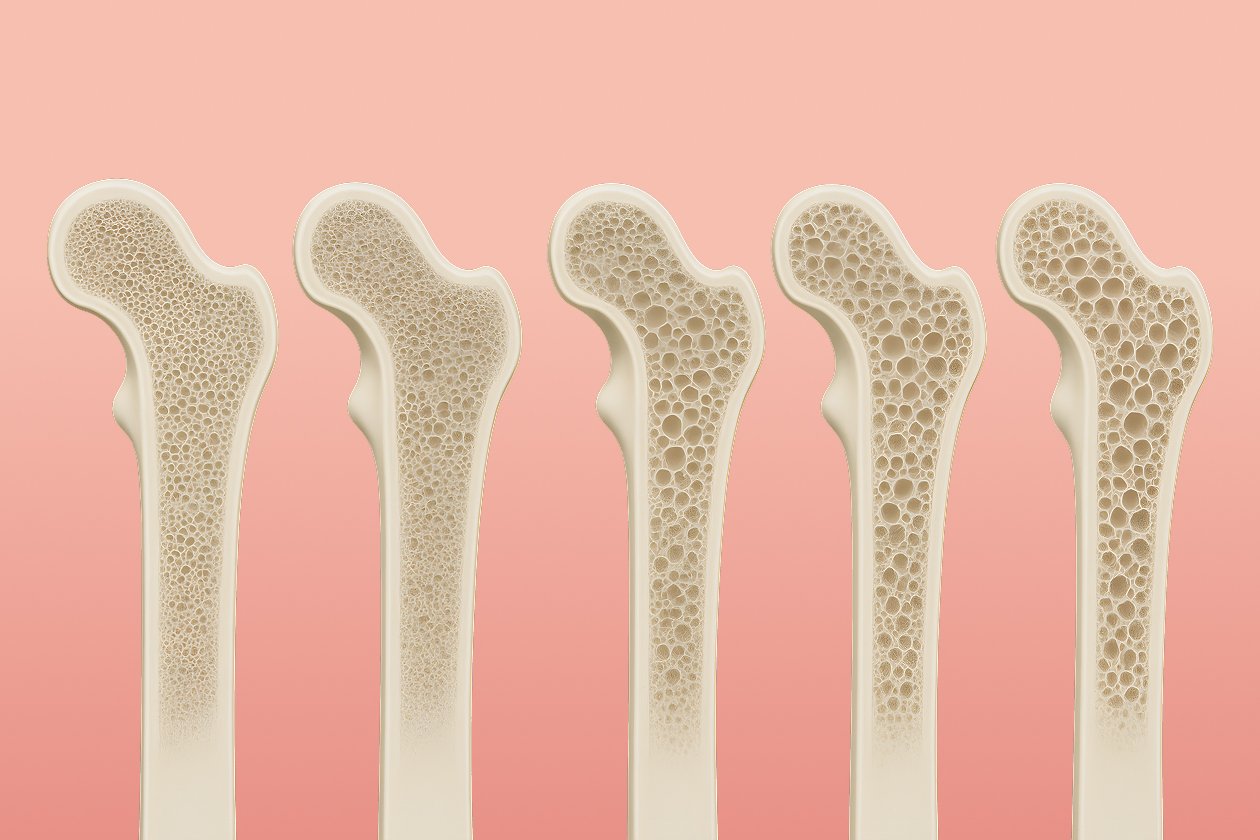
Osteoporosis – a major health concern for women
Perimenopause and menopause have strong effects on bone health: lower estrogen levels speed up bone density loss, making bones more fragile and raising the risk of osteoporosis (Silva et al., 2021). But bone health isn’t only about avoiding fractures. It’s about staying mobile, independent, and feeling good long-term.
The good news? We can do something about it! Targeted exercise, good posture, and the right nutrition are powerful tools to keep bones strong at every stage of life.
The key role of strength training
Many of us think of cardio as the “go-to” for health. But when it comes to bones, strength training is the real game-changer. Lifting, pushing, pulling: these movements load the skeleton, which stimulates bone production and helps maintain (or even increase) bone mineral density (Ihalainen et al., 2019).
Research shows resistance training not only lowers fracture risk but also improves posture and stability. Adding squats, lunges, or free weights into your routine is basically telling your bones: we need you to support our body.
Your spine is part of the foundation too
Posture plays a huge role in strength and stability. That’s where the concept of a neutral spine comes in. Dr. Kelly Starrett calls it the spine’s “happy position,” meaning the natural alignment of the neck, upper back, and lower back (Starrett, 2015; MUSC, 2019).
Why does this matter? Because good alignment spreads the load evenly across your skeleton, protects joints and discs, and lowers injury risk.
Two easy ways to check alignment:
- The wall test: Stand with your heels, upper back, and head against a wall. You’ll feel that neutral position right away.
- The two-hand rule: One hand on your sternum, the other on your pubic bone. If your hands move too far apart or too close, your posture is off.
These quick cues help protect your spine and pelvis, two areas that get more vulnerable with age.
Nutrition and bones: an inseparable duo
Weights alone won’t do the trick. Nutrition is just as important. Here are the key nutrients every bone-friendly diet needs:
- Calcium: the building block of bones. Found in dairy, broccoli, kale, and almonds (Rondanelli et al., 2021). This is one of the most important aspects of your diet. It’s highly recommended to get your calcium from actual food. Only taking calcium supplements to improve bone health is a myth!
One study found that post-menopausal women who took a daily 1,200 mg calcium supplement didn’t lower their risk of osteoporotic hip fractures compared to women who weren’t taking supplements. In fact, the supplement takers had a slightly increased risk of cardiac events, as well as kidney stones.
Why? Supplemental calcium may deposit in heart arteries, potentially increasing the risk of blockage.
Here’s a list of foods recommended that are high in calcium: https://osteoporosis.ca/calcium-food-sources/
- Vitamin D: essential for absorbing calcium. Sunlight helps, but in northern climates like ours, fortified foods or supplements are often needed (Rusu et al., 2024). It is recommended that every woman take at least 1000 IU of vitamin D per day as a supplement.
- Protein: supports both muscles and bone structure. Think Greek yogurt, eggs, fish, and legumes, animal protein, such as chicken (Agostini et al., 2018).
- Fiber: a healthy gut microbiome improves nutrient absorption (Basnet et al., 2024; Xu et al., 2017).Examples include quinoa, lentils, nuts, etc.
Here’s a free nutrient calculator from Osteoporosis Canada: https://osteoporosis.ca/nutrient-calculator/
Bottom line: a balanced diet is a cornerstone strategy for protecting bone density.
Preventing falls
Stronger bones are great, but reducing fall risk is just as important. As we age, balance and coordination can decline. Functional training plus posture practice (neutral spine!) improves stability and makes daily movement safer.
Even small things like bending, lifting, or climbing stairs become less risky with good alignment.
Benefits beyond bones
The best part? Bone-friendly habits boost way more than bone strength. Regular movement improves sleep, lowers stress, and lifts your mood. A nutrient-rich diet also supports heart health and overall energy.
So, looking after your bones has ripple effects that reach your whole body, and even your mind.
A simple action plan
- Move every week: mix strength training, light cardio, and balance work.
- Check your posture: practice neutral spine daily, at work or at home.
- Eat for your bones: add calcium, vitamin D, protein, and fiber to meals.
- Ask for guidance if needed: get professional support so you can practice safe, effective exercises. Our clinicians and health coaches are ready when you are.
Bone health is a true pillar of women’s well-being. By mixing strength training, neutral posture, and bone-friendly nutrition, you’re building a solid foundation for the years ahead. As a bonus, you get more energy, a brighter mood, and confidence in your body’s ability to move.
Taking care of your bones is really just an investment in your future, one small step at a time.
Disclaimer: The information provided here is for informational purposes only. It is not intended as medical advice. Always consult with your doctor or healthcare provider to determine what is best for your individual health needs.
References:
- Silva, T. R., Oppermann, K., Reis, F. M., & Spritzer, P. M. (2021). Nutrition in Menopausal Women: A Narrative Review. Nutrients, 13(7), 2149. https://doi.org/10.3390/nu13072149
- Ihalainen, J. K., Inglis, A., Mäkinen, T., Newton, R. U., Kainulainen, H., Kyröläinen, H., & Walker, S. (2019). Strength Training Improves Metabolic Health Markers in Older Individual Regardless of Training Frequency. Frontiers in Physiology, 10. https://doi.org/10.3389/fphys.2019.00032
- Becoming a Supple Leopard 2nd Edition by Dr. Kelly Starrett. (2015). The Ready State. https://thereadystate.com/product/becoming-a-supple-leopard-2nd-edition/
- Medical University of South Carolina. (2019). Posture Change With Age. Muschealth.org.https://muschealth.org/medical-services/geriatrics-and-aging/healthy-aging/posture
- Rondanelli, M., Peroni, G., Fossari, F., Vecchio, V., Faliva, M. A., Naso, M., Perna, S., Di Paolo, E., Riva, A., Petrangolini, G., Nichetti, M., & Tartara, A. (2021). Evidence of a Positive Link between Consumption and Supplementation of Ascorbic Acid and Bone Mineral Density. Nutrients, 13(3), 1012.
- Rusu, M. E., Bigman, G., Ryan, A. S., & Popa, D.-S. (2024). Investigating the Effects and Mechanisms of Combined Vitamin D and K Supplementation in Postmenopausal Women: An Up-to-Date Comprehensive Review of Clinical Studies. Nutrients, 16(14), 2356. https://doi.org/10.3390/nu16142356
- Agostini, D., Zeppa, S. D., Lucertini, F., Annibalini, G., Gervasi, M., Marini, C. F., Piccoli, G., Stocchi, V., Barbieri, E., & Sestili, P. (2018). Muscle and Bone Health in Postmenopausal Women: Role of Protein and Vitamin D Supplementation Combined with Exercise Training. Nutrients, 10(8), 1103. https://doi.org/10.3390/nu10081103
- Basnet, J., Eissa, M. A., Yanes Cardozo, L. L., Romero, D. G., & Rezq, S. (2024). Impact of Probiotics and Prebiotics on Gut Microbiome and Hormonal Regulation. Gastrointestinal Disorders, 6(4), 801–815. https://doi.org/10.3390/gidisord6040056
- Xu, H., Liu, J., Li, P., & Liang, Y. (2024). Effects of mind-body exercise on perimenopausal and postmenopausal women: a systematic review and meta-analysis. Menopause, 31(5), 457–467. https://doi.org/10.1097/gme.0000000000002336




